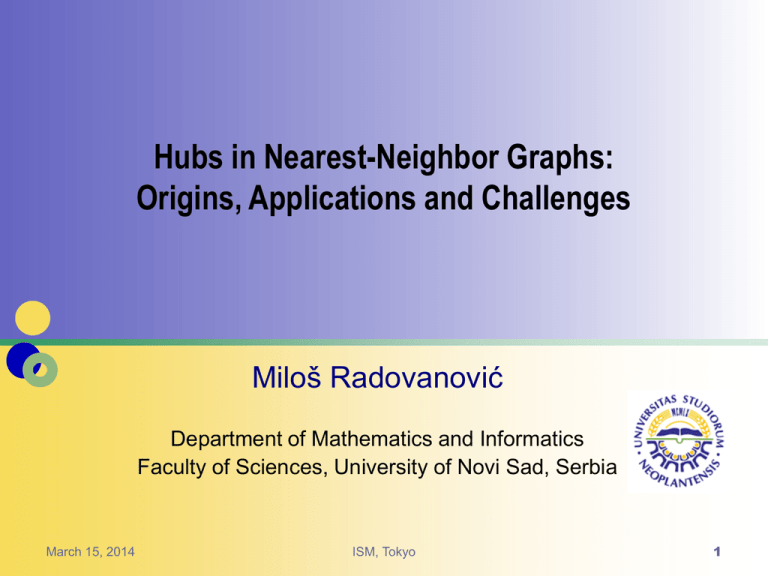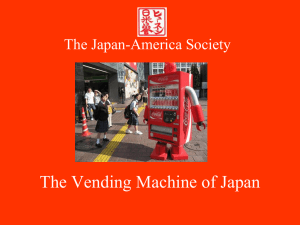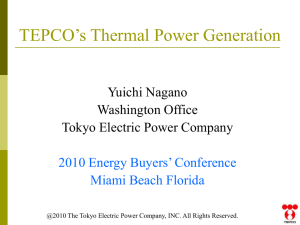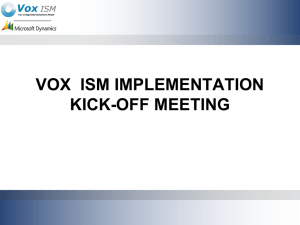Hubs in Nearest-Neighbor Graphs: Origins, Applications and
advertisement

Hubs in Nearest-Neighbor Graphs: Origins, Applications and Challenges Miloš Radovanović Department of Mathematics and Informatics Faculty of Sciences, University of Novi Sad, Serbia March 15, 2014 ISM, Tokyo 1 Thanks Workshop organizers Kenji Fukumizu Institute of Statistical Mathematics, Tokyo, Japan My coauthors Mirjana Ivanović Department of Mathematics and Informatics, Novi Sad, Serbia Alexandros Nanopoulos Ingolstadt School of Management, Germany Nenad Tomašev ex Jožef Stevan Institute, Ljubljana, Slovenia Google March 15, 2014 ISM, Tokyo 2 Outline Origins Definition, causes, distance concentration, real data, dimensionality reduction, large neighborhoods Applications Approach 1: Getting rid of hubness Approach 2: Taking advantage of hubness Challenges Outlier detection, kernels, causes – theory, kNN search, dimensionality reduction, others… March 15, 2014 ISM, Tokyo 3 The Hubness Phenomenon [Radovanović et al. ICML’09, Radovanović et al. JMLR’10] Nk(x), the number of k-occurrences of point x Rd, is the number of times x occurs among k nearest neighbors of all other points in a data set Nk(x) is the in-degree of node x in the kNN digraph It was observed that the distribution of Nk can become skewed, resulting in hubs – points with high Nk Music retrieval [Aucouturier & Pachet PR’07] Speaker verification (“Doddington zoo”) [Doddington et al. ICSLP’98] Fingerprint identification [Hicklin et al. NIST’05] Cause remained unknown, attributed to the specifics of data or algorithms March 15, 2014 ISM, Tokyo 4 March 15, 2014 ISM, Tokyo 5 March 15, 2014 ISM, Tokyo 6 Causes of Hubness Related phenomenon: concentration of distance / similarity High-dimensional data points approximately lie on a sphere centered at any fixed point [Beyer et al. ICDT’99, Aggarwal & Yu SIGMOD’01] The distribution of distances to a fixed point always has non-negligible variance [François et al. TKDE’07] As the fixed point we observe the data set center E Std = √Var Centrality: points closer to the data set center tend to be closer to all other points (regardless of dimensionality) Centrality is amplified by high dimensionality March 15, 2014 ISM, Tokyo 7 Causes of Hubness Standard normal distribution of data Distribution of Euclidean distances of points to data set center (0) = Chi distribution with d degrees of freedom ||X|| March 15, 2014 ISM, Tokyo 8 Causes of Hubness Standard normal distribution of data Distribution of Euclidean distances of points to: - Point at expected distance from 0: E(||X||) (dashed lines) - Point 2 standard deviations closer: E(||X||) – 2·Std(||X||) (full lines) = Noncentral Chi distribution with d degrees of freedom March 15, 2014 ISM, Tokyo 9 Causes of Hubness Theorem [Radovanović et al. JMLR’10]: The ascending behavior holds for iid normal data and any two points at distances E + c1·Std and E + c2·Std, for c1, c2 ≤ 0, c1 < c2 In the above example: c1 = –2, c2 = 0 [Suzuki et al. EMNLP’13] discuss similar result for dot-product similarity and more arbitrary data distribution (details in the next talk) March 15, 2014 ISM, Tokyo 10 Important to Emphasize Generally speaking, concentration does not CAUSE hubness Causation might be possible to derive under certain assumptions Example settings with(out) concentration and with(out) hubness: C+, H+: C–, H+: C+, H–: C–, H–: iid uniform data, Euclidean dist. iid uniform data, squared Euclidean dist. iid normal data (centered at 0), cosine sim. spatial Poisson process data, Euclidean dist. Two “ingredients” needed for hubness: 1) 2) High dimensionality Centrality (existence of centers / borders) March 15, 2014 ISM, Tokyo 11 Hubness in Real Data Important factors for real data 1) 2) 50 data sets Dependent attributes Grouping (clustering) From well known repositories (UCI, Kent Ridge) Euclidean and cosine, as appropriate Conclusions [Radovanović et al. JMLR’10]: 1) 2) Hubness depends on intrinsic dimensionality Hubs are in proximity of cluster centers March 15, 2014 ISM, Tokyo 12 March 15, 2014 ISM, Tokyo 13 Hubness and Dimensionality Reduction PCA 1.5 SN 10 Intrinsic dimensionality reached 1 0.5 musk1 mfeat-factors spectrometer iid uniform, d =15,no PCA 0 -0.5 0 20 40 60 80 100 Features (%) Similar charts for ICA, SNE, isomap, diffusion maps March 15, 2014 ISM, Tokyo 14 Hubness in Real Data Existence of hubness in real data and dependence on dimensionality verified: Various UCI, microarray and text data sets [Radovanović et al. JMLR’10] Collaborative filtering data [Nanopoulos et al. RecSys’09, Knees et al. ICMR’14] Vector space models for text retrieval [Radovanović et al. SIGIR’10] Time series data and “elastic” distance measures (DTW) [Radovanović et al. SDM’10] Content-based music retrieval data [Karydis et al. ISMIR’10, Flexer et al. ISMIR’12] Doddington zoo in speaker verification [Schnitzer et al. EUSIPCO’13] Image data with invariant local features (SIFT, SURF, ORB) [Tomašev et al. ICCP’13] Oceanographic sensor data [Tomašev and Mladenić IS’11] … March 15, 2014 ISM, Tokyo 15 There Are Also Critics [Low et al. STUDFUZZ’13] “The Hubness Phenomenon: Fact or Artifact?” “we challenge the hypothesis that the hubness phenomenon is an effect of the dimensionality of the data set and provide evidence that it is rather a boundary effect or, more generally, an effect of a density gradient” The “challenge” is easy to overcome by referring to more careful reading of [Radovanović et al. JMLR’10] Nevertheless, the paper articulates the notion of density gradient (empirically), which could prove valuable March 15, 2014 ISM, Tokyo 16 Hubness and Large Neighborhoods March 15, 2014 ISM, Tokyo 17 Hubness and Large Neighborhoods March 15, 2014 ISM, Tokyo 18 Hubness and Large Neighborhoods March 15, 2014 ISM, Tokyo 19 Outline Origins Definition, causes, distance concentration, real data, dimensionality reduction, large neighborhoods Applications Approach 1: Getting rid of hubness Approach 2: Taking advantage of hubness Challenges Outlier detection, kernels, causes – theory, kNN search, dimensionality reduction, others… March 15, 2014 ISM, Tokyo 20 Approaches to Handling Hubs Hubness is a problem – let’s get rid of it 2. Hubness is OK – let’s take advantage of it 1. Hubness present in many kinds of real data and application domains We will review research that actively takes hubness into account (in an informed way) But first… March 15, 2014 ISM, Tokyo 21 Hubness and Classification Based on labels, k-occurrences can be distinguished into: “Bad” k-occurrences, BNk(x) “Good” k-occurrences, GNk(x) Nk(x) = BNk(x) + GNk(x) “Bad” hubs can appear How do “bad” hubs originate? March 15, 2014 Observations on real data ISM, Tokyo 22 How Do “Bad” Hubs Originate? The cluster assumption [Chapelle et al. 2006]: Most pairs of points in a cluster should be of the same class High violation Low violation Observations and answers [Radovanović et al. JMLR’10]: High dimensionality and skewness of Nk do not automatically induce “badness” “Bad” hubs originate from a combination of 1) high (intrinsic) dimensionality 2) violation of the cluster assumption March 15, 2014 ISM, Tokyo 23 In More General Terms General notion of “error” Classification error (accuracy) Retrieval error (precision, recall, F-measure) Clustering error (within/between cluster distance) Models make errors, but the responsibility for error is not evenly distributed among data points Important to distinguish: Total amount of (responsibility for) error in the data E.g. Σx BNk(x) / Σx Nk(x) Distribution of (responsibility for) error among data points March 15, 2014 E.g. distribution of BNk(x), i.e. its skewness ISM, Tokyo 24 In More General Terms Hubness generally does not increase the total amount of error Hubness skews the distribution of error, so some points will be more responsible for error than others Approach 1 (getting rid of hubness) May reduce (but also increase) total amount of error in the data Will make distribution of error more uniform Approach 2 (taking advantage of hubness) Will not change total amount of error in the data Will identify points more responsible for error and adjust models accordingly March 15, 2014 ISM, Tokyo 25 Outline Origins Definition, causes, distance concentration, real data, dimensionality reduction, large neighborhoods Applications Approach 1: Getting rid of hubness Approach 2: Taking advantage of hubness Challenges Outlier detection, kernels, causes – theory, kNN search, dimensionality reduction, others… March 15, 2014 ISM, Tokyo 26 Mutual kNN Graphs [Ozaki et al. CoNLL’11] Graph-based semi-supervised text classification kNN graphs Mutual kNN graphs + maximum spanning trees b-matching graphs [Jebara et al. ICML’09] Mutual kNN graphs perform better than kNN graphs (and comparably to b-matching graphs) due to reduced hubness March 15, 2014 ISM, Tokyo 27 Centering and Hub Reduction [Suzuki et al. AAAI’12] Ranking (IR), multi-class and multi-label kNN classification Laplacian-based kernels tend to make all points equally similar to the center, thus reducing hubness (compared to plain cosine similarity) When hubness is reduced, the kernels work well [Suzuki et al. EMNLP’13] Text classification Centering reduces hubness, since it also makes all points equally similar to the center, using dot-product similarity I would add, centering reduces centrality (the existence of centers in the data) w.r.t dot-product similarity For multi-cluster data, weighted centering which moves hubs closer to the center achieves a similar effect March 15, 2014 ISM, Tokyo 28 Local and Global Scaling [Schnitzer et al. JMLR’12] Content-based music retrieval Idea: rescale distances from x and y so that distance is small only if x is a close neighbor to y and y is a close neighbor to x Local scaling: non-iterative contextual dissimilarity measure LS(dx,y) = dx,y / (μx μy)½ where μx (μy) is the avg. distance from x (y) to its k NNs Global scaling: mutual proximity MP(dx,y) = P(X > dx,y ∩ Y > dy,x) where X (Y) follows the distribution of distances from x (y) to all other points March 15, 2014 ISM, Tokyo 29 Mutual Proximity Visualized March 15, 2014 ISM, Tokyo 30 Properties of LS and MP Both LS and MP reduce hubness, improving kNN classification accuracy MP easier to approximate for large data, successfully applied to music retrieval Methods do not reduce intrinsic dimensionality of data Hubs/anti-hubs remain as such, but to a lesser degree Regarding error (“badness”), the methods: Reduce badness of hubs Introduce badness to anti-hubs Badness of regular points stays roughly the same, but less than for both hubs and anti-hubs LS can benefit from varying neighborhood size based on class labels or clustering [Lagrange et al. ICASSP’12] MP successfully applied to neighbor-based collaborative filtering [Knees et al. ICMR’14] MP improves data point coverage in NN graph March 15, 2014 ISM, Tokyo 31 Shared Nearest Neighbors [Flexer & Schnitzer HDM’13] Classification Consider shared neighbor similarity: SNN(x,y) = |Dk(x) ∩ Dk(y)| / k where Dk(x) is the set of k NNs of x Use this measure for computing the kNN graph SNN reduces hubness, but not as much as LS and MP SNN can improve kNN classification accuracy, but overall worse than LS and MP March 15, 2014 ISM, Tokyo 32 A Case for Hubness Removal [Schnitzer et al. ECIR’14] Multimedia retrieval: text, images, music SNN, and especially LS and MP, in all above domains: Reduce hubness Improve data point coverage (reachability) Improve retrieval precision/recall March 15, 2014 ISM, Tokyo 33 Other Ways to Avoid Hubs [Murdock and Yaeger ECAL’11] Using clustering to identify species in genetic algorithms QT clustering algorithm uses ε-neighborhoods, where there is no hubness [Lajoie et al. Genome Bilogy’12] Regulatory element discovery from gene expression data kNN graph between genes is first symmetrized k neighbors sampled with probability inversely proportional to Nk [Schlüter MSc’11] Overview and comparison of methods for hub reduction in music retrieval Methods mostly unaware of the true cause of hubness March 15, 2014 ISM, Tokyo 34 Outline Origins Definition, causes, distance concentration, real data, dimensionality reduction, large neighborhoods Applications Approach 1: Getting rid of hubness Approach 2: Taking advantage of hubness Challenges Outlier detection, kernels, causes – theory, kNN search, dimensionality reduction, others… March 15, 2014 ISM, Tokyo 35 Extending the kNN Classifier “Bad” hubs provide erroneous class information to many other points hw-kNN [Radovanović et al. JMLR’10]: We introduce standardized “bad” hubness: hB(x, k) = (BNk(x) – μBNk) / σBNk During majority voting, the vote of each neighbor x is weighted by exp(–hB(x, k)) March 15, 2014 ISM, Tokyo 36 Extending the kNN Classifier Drawbacks of hw-kNN: Does not distinguish between classes when computing “badness” of a point Still uses the crisp voting scheme of kNN Consider class-specific hubness scores Nk,c(x): The number of k-occurrences of x in neighbor sets of class c h-FNN, Hubness-based Fuzzy NN [Tomašev et al. MLDM’11, IJMLC]: Vote in a fuzzy way by class-specific hubness scores Nk,c(x) NHBNN, Naïve Hubness Bayesian NN [Tomašev et al. CIKM’11]: Compute a class probability distribution based on Nk,c(x) HIKNN, Hubness Information kNN [Tomašev & Mladenić ComSIS’12]: Information-theoretic approach using Nk,c(x) ANHBNN, Augmented Naïve Hubness Bayesian NN [Tomašev & Mladenić ECML’13]: Extends NHBNN using the Hidden Naïve Bayes model to take into account hub cooccurrences in NN lists March 15, 2014 ISM, Tokyo 37 Why Hub-Based Classifiers Work [Tomašev & Mladenić, KBS’13] Data with imbalanced classes “Bad” hubs from MINORITY classes usually responsible for most error Favoring minority class data points (standard approach) makes the problem worse Hubness-based classifiers improve precision on minority classes and recall on majority classes May be beneficial to combine the hubness-aware voting approaches with the existing class imbalanced kNN classifiers Realistically, minority classes need to be favored Minority (bad) hubs need to be taken into account March 15, 2014 ISM, Tokyo 38 Clustering [Radovanović et al. JMLR’10] Distance-based clustering objectives: Minimize within-cluster distance Maximize between-cluster distance Skewness of Nk affects both objectives Outliers do not cluster well because of high within-cluster distance Hubs also do not cluster well, but because of low betweencluster distance March 15, 2014 ISM, Tokyo 39 Clustering Silhouette coefficient (SC): For i-th point ai = avg. distance to points from its cluster (within-cluster distance) bi = min. avg. distance to points from other clusters (between-cluster distance) SCi = (bi – ai) / max(ai, bi) In range [–1, 1], higher is better SC for a set of points is the average of SCi for every point i in the set March 15, 2014 ISM, Tokyo 40 Clustering [Tomašev et al. submitted] March 15, 2014 ISM, Tokyo 41 Using Hubs as Cluster Centers [Tomašev et al. PAKDD’11, TKDE’14] March 15, 2014 ISM, Tokyo 42 Exploiting the Hubness of Points March 15, 2014 ISM, Tokyo 43 Exploiting the Hubness of Points March 15, 2014 ISM, Tokyo 44 Exploiting the Hubness of Points Algorithm 3 HPKM The same as HPC, except for one line HPC: HPKM: “Kernelized” extension of HPKM [Tomašev et al. submitted] March 15, 2014 ISM, Tokyo 45 Why Hub-Based Clustering Works Hub-based clustering more robust to noise Improves between-cluster distance (b component of SC), especially for hubs Miss-America, Part 1 March 15, 2014 Miss-America, Part 2 ISM, Tokyo 46 Instance Selection [Buza et al. PAKDD’11] Improve speed and accuracy of 1NN time-series classification Select a small percentage of instances x based on largest GN1(x) GN1(x) / (N1(x) + 1) GN1(x) – 2BN1(x) The approach using GN1(x) is optimal in the sense of producing the best 1NN coverage (label-matching) graph [Lazaridis et al. Signal Processing: Image Communication’13] Multimodal indexing of multimedia objects (text, 2D image, sketch, video, 3D objects, audio and their combinations) Select dimensionality of multimodal feature space (20) to maximize hubness while keeping computational cost reasonable Select reference objects for indexing as strongest hubs March 15, 2014 ISM, Tokyo 47 Instance Selection [Radovanović et al. JMLR’10] Support vector machine classifier Bad hubs tend to be good support vectors [Kouimtzis MSc’11] Confirm and refine above observation Observe ratio BNk(x) / GNk(x) Two selection methods: RatioOne: Prefer ratios closest to 1 in absolute value BelowOne: Prefer ratios lower than 1 BelowOne performs better than random selection RatioOne comparable to BelowOne only on larger sample sizes BelowOne selects instances on the border, but closer to class centers March 15, 2014 ISM, Tokyo 48 Local Image Feature Selection [Wang et al. PR’11] Improving image-to-class (I2C) distance Image features extracted locally from each image, and thus have: Vector descriptors (that can be compared) Associated class information (of the image) Reduce cost of NN search in testing phase by: Removing features with low Nk Keeping features with high GNk / BNk March 15, 2014 ISM, Tokyo 49 Cross-Lingual Document Retrieval [Tomašev et al. PAKDD’13] Acquis aligned corpus data (labeled), focus on English and French Frequent neighbor documents among English texts are usually also frequent neighbors among French texts Good/bad neighbor documents in English texts are expected to be good/bad neighbor documents in French Canonical correlation analysis (CCA) is a dimensionality reduction technique similar to PCA, but: Assumes the data comes from two views that share some information (such as a bilingual document corpus) Instead of looking for linear combinations of features that maximize the variance it looks for a linear combination of feature vectors from the first view and a linear combination from the second view, that are maximally correlated Introduce instance weights that (de)emphasize (bad) hubs in CCA Emphasizing hubs gives most improvement in classification and retrieval tasks March 15, 2014 ISM, Tokyo 50 Similarity Adjustment [Radovanović et al. SIGIR’10] Document retrieval in the vector space model (TF-IDF + cosine sim., BM25, pivoted cosine) For document x, query q, we adjust similarity sim(x, q) as follows: sima(x, q) = sim(x, q) + sim(x, q) · (GNk(x) – BNk(x)) / Nk(x) [Tomašev et al. ITI’13] Bug duplicate detection in software bug tracking systems (TF-IDF + cosine sim. over bug report text) Similarity adjustment, observing only the past μ occurrences of x: sima(x, q) = sim(x, q) + sim(x, q) · GNk,μ(x) / Nk,μ (x) March 15, 2014 ISM, Tokyo 51 An Approach in Between [Tomašev & Mladenić, HAIS’12, KAIS] Image classification Consider shared neighbor similarity: SNN(x,y) = |Dk(x) ∩ Dk(y)| / k where Dk(x) is the set of k NNs of x Propose a modified measure simhub which Increases the influence of rare neighbors Reduces the influence of “bad” hubs (considering class-specific hubness Nk,c(x) from an information-theoretic perspective) simhub: Reduces total amount of error (badness) Reduces hubness Bad hubs no longer correlate with hubs (distribution of error is changed) March 15, 2014 ISM, Tokyo 52 Outline Origins Definition, causes, distance concentration, real data, dimensionality reduction, large neighborhoods Applications Approach 1: Getting rid of hubness Approach 2: Taking advantage of hubness Challenges Outlier detection, kernels, causes – theory, kNN search, dimensionality reduction, others… March 15, 2014 ISM, Tokyo 53 Outlier Detection [Radovanović et al. JMLR’10] In high dimensions, points with low Nk can be considered distance-based outliers They are far away from other points in the data set / their cluster High dimensionality contributes to their existence ionosphere sonar 40 40 Nk 60 Nk 60 20 0 0 20 2 4 6 8 10 Dist. from k-th NN March 15, 2014 0 4 12 (k = 20) ISM, Tokyo 6 8 10 12 14 16 Dist. from k-th NN 54 Outlier Detection Challenges [Radovanović et al. submitted]: For high-dimensional data and low k many points have Nk values of 0 Raising k can help, but: Cluster boundaries can be crossed, producing meaningless results Computational complexity is raised; approximate NN search/indexing methods do not work any more March 15, 2014 ISM, Tokyo 55 Kernels Little is known about the effects of different kernels (and their parameters) on hubness And vice versa, hubness can be a good vehicle for understanding the effects of kernels on data distributions For given kernel function K(x,y) and norm distance metric D(x,y) in Hilbert space, D2(Ψ(x),Ψ(y)) = K(x,x) − 2K(x,y) + K(y,y) Preliminary investigation in [Tomašev et al. submitted], in the context of kernelized hub-based clustering Other possible applications: kernelized clustering in general, kernel-kNN classifier, SVMs (with only a start given in [Kouimtzis MSc’11])… March 15, 2014 ISM, Tokyo 56 Kernels [Tomašev et al. submitted]: polynomial kernel K(x,y) = (1 + <x,y>)p March 15, 2014 ISM, Tokyo 57 Causes of Hubness: Theory Theoretical contribution of [Radovanović et al. JMLR’10] only in terms of properties of distances Good strides made in [Suzuki et al. EMNLP’13] for dot-product similarity More needs to be done: Explain the causes of hubness theoretically for a large class of distances and data distributions Characterize the distribution of Nk based on the distribution of data, distance measure, number of data points, k Explore the effects of different types of normalization Understand the difference between kNN and ε-neighborhood graphs Practical benefits: Geometric models of complex networks (mapping graphs to Rd) Intrinsic dimensionality estimation … March 15, 2014 ISM, Tokyo 58 (Approximate) kNN Search / Indexing HUGE virtually untouched area, with great practical importance We did some preliminary experiments, showing that hubness is not severely affected by method from [Chen et al. JMLR’09] [Lazaridis et al. 2013] used hubness in a specific multimedia context Need for comprehensive systematic exploration of: Interaction between hubness and existing methods Construction of new “hubness-aware” methods Possible need for methods that do not assume k = O(1) March 15, 2014 ISM, Tokyo 59 Dimensionality Reduction Apart from simulations in [Radovanović et al. JMLR’10] and instance weighting for CCA in [Tomašev et al. PAKDD’13], practically nothing done Many possibilities: Improved objective functions for distance-preserving dimensionality reduction (MDS, PCA) In order to better preserve kNN graph structure Or break the kNN graph in a controlled way Improve methods based on geodesic distances (Isomap, etc.) … March 15, 2014 ISM, Tokyo 60 Other (Possible) Applications Information retrieval Investigation of short queries, large data sets Learning to rank Local image features (SIFT, SURF…) Hubness affects formation of codebook representations Normalization plays and important role Protein folding Suggestions? March 15, 2014 ISM, Tokyo 61 References M. Radovanović et al. Nearest neighbors in high-dimensional data: The emergence and influence of hubs. In Proc. 26th Int. Conf. on Machine Learning (ICML), pages 865– 872, 2009. M. Radovanović et al. Hubs in space: Popular nearest neighbors in high-dimensional data. Journal of Machine Learning Research,11:2487–2531, 2010. J.-J. Aucouturier and F. Pachet. A scale-free distribution of false positives for a large class of audio similarity measures. Pattern Recognition, 41(1):272–284, 2007. G. Doddington et al. SHEEP, GOATS, LAMBS and WOLVES: A statistical analysis of speaker performance in the NIST 1998 speaker recognition evaluation. In Proc. 5th Int. Conf. on Spoken Language Processing (ICSLP), 1998. Paper 0608. A. Hicklin et al. The myth of goats: How many people have fingerprints that are hard to match? Internal Report 7271, National Institute of Standards and Technology (NIST), USA, 2005. I. Suzuki et al. Centering similarity measures to reduce hubs. In Proc. Conf. on Empirical Methods in Natural Language Processing (EMNLP), pages 613–623, 2013. K. S. Beyer et al. When is “nearest neighbor” meaningful? In Proc. 7th Int. Conf. on Database Theory (ICDT), pages 217–235, 1999. C. C. Aggarwal and P. S. Yu. Outlier detection for high dimensional data. In Proc. 27th ACM SIGMOD Int. Conf. on Management of Data, pages 37–46, 2001. D. François et al. The concentration of fractional distances. IEEE Transactions on Knowledge and Data Engineering, 19(7):873–886, 2007. March 15, 2014 ISM, Tokyo 62 A. Nanopoulos et al. How does high dimensionality affect collaborative filtering? In Proc. 3 rd ACM Conf. on Recommender Systems (RecSys), pages 293–296, 2009. P. Knees et al. Improving neighborhood-based collaborative filtering by reducing hubness. Proc. 4th ACM Int. Conf. on Multimedia Retrieval (ICMR), 2014 (to appear) M. Radovanović et al. On the existence of obstinate results in vector space models. In Proc. 33rd Annual International ACM SIGIR Conference on Research and Development in Information Retrieval, pages 186–193, 2010. M. Radovanović et al. Time-series classification in many intrinsic dimensions. In Proc. 10th SIAM Int. Conf. on Data Mining (SDM), pages 677–688, 2010. I. Karydis et al. Looking through the “glass ceiling”: A conceptual framework for the problems of spectral similarity. In Proc. 11th International Society for Music Information Retrieval Conference (ISMIR), pages 267–272, 2010. A. Flexer et al. A MIREX meta-analysis of hubness in audio music similarity. In Proc. 13th International Society for Music Information Retrieval Conference (ISMIR), pages 175–180, 2012. D. Schnitzer et al. The relation of hubs to the Doddington zoo in speaker verification. In Proc. 21st European Signal Processing Conf. (EUSIPCO), 2013. N. Tomašev et al. Object recognition in WIKImage data based on local invariant image features. In Proc. 9th Int. Conf. on Intelligent Computer Communication and Processing (ICCP), pages 139–146, 2013. N. Tomašev and D. Mladenić. Exploring the hubness-related properties of oceanographic sensor data. In Proc. 4th Int. Multiconf. on Information Society (IS), Volume A, pages 149–152, 2011. T. Low et al. The hubness phenomenon: Fact or artifact? In C. Borgelt et al (eds.): Towards Advanced Data Analysis by Combining Soft Computing and Statistics, pages 267– 278, Springer, 2013. March 15, 2014 ISM, Tokyo 63 O. Chapelle et al., editors. Semi-Supervised Learning. MIT Press, 2006. K. Ozaki et al. Using the mutual k-nearest neighbor graphs for semi-supervised classification of natural language data. In Proc. 15th Conf. on Computational Natural Language Learning (CoNLL), pages 154–162, 2011. T. Jebara et al. Graph construction and b-matching for semi-supervised learning. In Proc. 26th Int. Conf. on Machine Learning (ICML), pages 441–448, 2009. I. Suzuki et al. Investigating the effectiveness of Laplacian-based kernels in hub reduction. In Proc. 26th AAAI Conf. on Artificial Intelligence, pages 1112–1118, 2012. D. Schnitzer et al. Local and global scaling reduce hubs in space. Journal of Machine Learning Research 13:2871–2902, 2012. M. Lagrange et al. Cluster aware normalization for enhancing audio similarity. In Proc. IEEE Int. Conf. on Acoustics, Speech and Signal Processing (ICASSP), 2012. A. Flexer and D. Schnitzer. Can shared nearest neighbors reduce hubness in highdimensional spaces? In Proc. 1st International Workshop on High Dimensional Data Mining (HDM), 2013 D. Schnitzer et al. A case for hubness removal in high-dimensional multimedia retrieval. In Proc. 36th European Information Retrieval Conference (ECIR), 2014 (to appear) J. Murdock and L. S. Yaeger. Identifying species by genetic clustering. In Proc. 20th European Conf. on Artificial Life (ECAL), pages 565–572, 2011. M. Lajoie et al. Computational discovery of regulatory elements in a continuous expression space. Genome Biology 13(11):R109, 2012. J. Schlüter. Unsupervised Audio Feature Extraction for Music Similarity Estimation. MSc thesis, Faculty of Informatics, Technical University of Munich, Munich, Germany, 2011. March 15, 2014 ISM, Tokyo 64 N. Tomašev et al. Hubness-based fuzzy measures for high-dimensional k-nearest neighbor classification. In Proc. 7th Int. Conf. on Machine Learning and Data Mining (MLDM), pages 16–30, New York, USA, 2011. N. Tomašev et al. Hubness-based fuzzy measures for high-dimensional k-nearest neighbor classification. International Journal of Machine Learning and Cybernetics, DOI: 10.1007/s13042-012-0137-1 (to appear). N. Tomašev et al. A probabilistic approach to nearest-neighbor classification: Naive hubness Bayesian kNN. In Proc. 20th ACM Int. Conf. on Information and Knowledge Management (CIKM), pages 2173–2176, 2011. N. Tomašev and D. Mladenić. Hub co-occurrence modeling for robust high-dimensional kNN classification. In Proc. 24th European Conf. on Machine Learning (ECML), 2013. N. Tomašev and D. Mladenić. Class imbalance and the curse of minority hubs. Knowledge-Based Systems, 53:157–172, 2013. N. Tomašev et al. The role of hubness in clustering high-dimensional data. In Proc. 15th Pacific-Asia Conf. on Knowledge Discovery and Data Mining (PAKDD), Part I, pages 183–195, 2011. N. Tomašev et al. The role of hubness in clustering high-dimensional data. IEEE Transactions on Knowledge and Data Engineering, 26(3):739–751, 2014. K. Buza et al. INSIGHT: Efficient and effective instance selection for time-series classification. In Proc. 15th Pacific-Asia Conf. on Knowledge Discovery and Data Mining (PAKDD), Part II, pages 149–160, 2011. M. Lazaridis et al. Multimedia search and retrieval using multimodal annotation propagation and indexing techniques. Signal Processing: Image Communication, 28(4):351–367, 2013. March 15, 2014 ISM, Tokyo 65 G. Kouimtzis. Investigating the Impact of Hubness on SVM Classifiers. MSc thesis, Department of Information & Communication Systems Engineering, University of the Aegean, Karlovassi, Samos, Greece, 2011. Z. Wang et al. Improved learning of I2C distance and accelerating the neighborhood search for image classification. Pattern Recognition, 44(10–11):2384–2394, 2011. N. Tomašev et al. The role of hubs in supervised cross-lingual document retrieval. In Proc. 17th Pacific-Asia Conf. on Knowledge Discovery and Data Mining (PAKDD), Part II, pages 185–196, 2013. N. Tomašev et al. Exploiting hubs for self-adaptive secondary re-ranking in bug report duplicate detection. In Proc. 35th Int. Conf. on Information Technology Interfaces (ITI), 2013. N. Tomašev and D. Mladenić. Hubness-aware shared neighbor distances for highdimensional k-nearest neighbor classification. In Proc. 7th Int. Conf. on Hybrid Artificial Intelligence Systems (HAIS), Part II, pages 116–127, 2012. N. Tomašev and D. Mladenić. Hubness-aware shared neighbor distances for highdimensional k-nearest neighbor classification. Knowledge and Information Systems, DOI: 10.1007/s10115-012-0607-5 (to appear). J. Chen et al. Fast approximate kNN graph construction for high dimensional data via recursive Lanczos bisection. Journal of Machine Learning Research, 10:1989–2012, 2009. March 15, 2014 ISM, Tokyo 66







